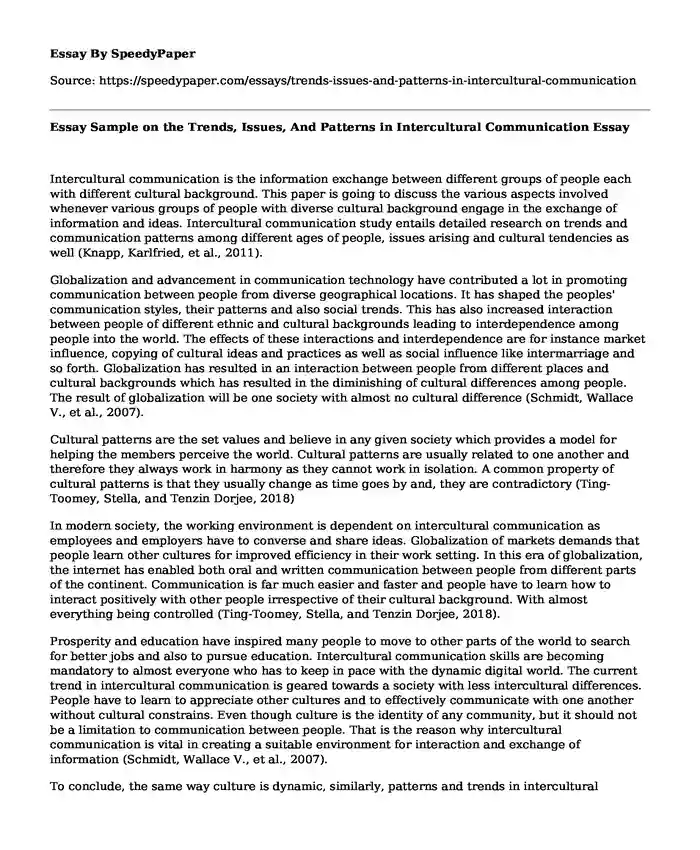
| Type of paper: | Speech |
| Categories: | Intercultural communication |
| Pages: | 3 |
| Wordcount: | 639 words |
Intercultural communication is the information exchange between different groups of people each with different cultural background. This paper is going to discuss the various aspects involved whenever various groups of people with diverse cultural background engage in the exchange of information and ideas. Intercultural communication study entails detailed research on trends and communication patterns among different ages of people, issues arising and cultural tendencies as well (Knapp, Karlfried, et al., 2011).
Globalization and advancement in communication technology have contributed a lot in promoting communication between people from diverse geographical locations. It has shaped the peoples' communication styles, their patterns and also social trends. This has also increased interaction between people of different ethnic and cultural backgrounds leading to interdependence among people into the world. The effects of these interactions and interdependence are for instance market influence, copying of cultural ideas and practices as well as social influence like intermarriage and so forth. Globalization has resulted in an interaction between people from different places and cultural backgrounds which has resulted in the diminishing of cultural differences among people. The result of globalization will be one society with almost no cultural difference (Schmidt, Wallace V., et al., 2007).
Cultural patterns are the set values and believe in any given society which provides a model for helping the members perceive the world. Cultural patterns are usually related to one another and therefore they always work in harmony as they cannot work in isolation. A common property of cultural patterns is that they usually change as time goes by and, they are contradictory (Ting-Toomey, Stella, and Tenzin Dorjee, 2018)
In modern society, the working environment is dependent on intercultural communication as employees and employers have to converse and share ideas. Globalization of markets demands that people learn other cultures for improved efficiency in their work setting. In this era of globalization, the internet has enabled both oral and written communication between people from different parts of the continent. Communication is far much easier and faster and people have to learn how to interact positively with other people irrespective of their cultural background. With almost everything being controlled (Ting-Toomey, Stella, and Tenzin Dorjee, 2018).
Prosperity and education have inspired many people to move to other parts of the world to search for better jobs and also to pursue education. Intercultural communication skills are becoming mandatory to almost everyone who has to keep in pace with the dynamic digital world. The current trend in intercultural communication is geared towards a society with less intercultural differences. People have to learn to appreciate other cultures and to effectively communicate with one another without cultural constrains. Even though culture is the identity of any community, but it should not be a limitation to communication between people. That is the reason why intercultural communication is vital in creating a suitable environment for interaction and exchange of information (Schmidt, Wallace V., et al., 2007).
To conclude, the same way culture is dynamic, similarly, patterns and trends in intercultural communications are too. Intercultural communication is affected by technology advancements and also people thoughts are advancing. In business sectors, business people have to understand intercultural trends to adjust accordingly for more profits. The biggest threat to intercultural communication is ethnocentrism where one believes that their race or culture is superior to that of others. This hinders communication and can result in conflict on a cultural basis (Rafailova, Genka, and Stoyan Marinov, 2019).
References
Knapp, K., Enninger, W., & Knapp-Potthoff, A. (2011). Analyzing Intercultural Communication. Berlin: Walter de Gruyter.
Rafailova, G., & Marinov, S. (2019). Tourism and Intercultural Communication and Innovations. Newcastle upon Tyne: Cambridge Scholars Publishing.
Schmidt, W. V., Conaway, R. N., Easton, S. S., & Wardrope, W. J. (2007). Communicating Globally: Intercultural Communication and International Business. SAGE.
Ting-Toomey, S. (2012). Communicating Across Cultures, First Edition. Guilford P.
Ting-Toomey, S., & Dorjee, T. (2018). Communicating Across Cultures, Second Edition. Guilford Publications.
Cite this page
Essay Sample on the Trends, Issues, And Patterns in Intercultural Communication. (2022, Feb 24). Retrieved from https://speedypaper.net/essays/trends-issues-and-patterns-in-intercultural-communication
Request Removal
If you are the original author of this essay and no longer wish to have it published on the SpeedyPaper website, please click below to request its removal:
- How Bad Is China from the Perspectives of U.S. Companies? Free Essay
- Free Essay with Cargo Airlines Research
- Civil War Essay Sample: Crittenden Compromise and Missouri Compromise
- Skills and Labor Shortage in Hospitality Company - HRM Essay Example
- Impact of Religious Observance in Education. Free Essay Sample.
- Free Essay: History of Mathematical Puzzles
- The Case Study: CSR Reputation of Intel Corporation
Popular categories




